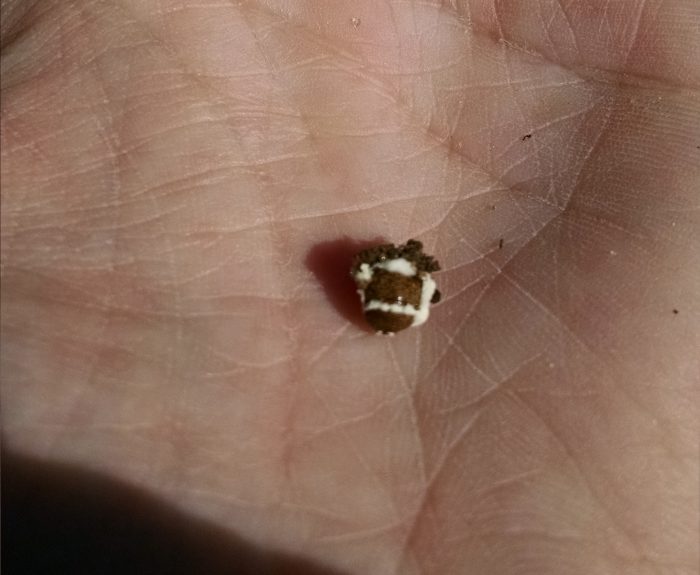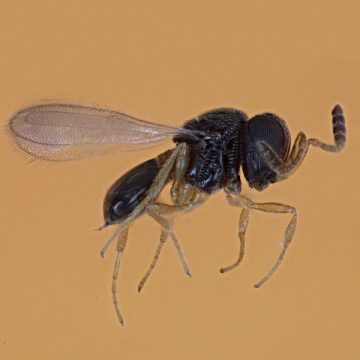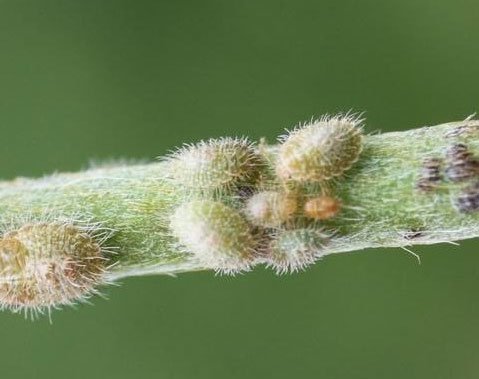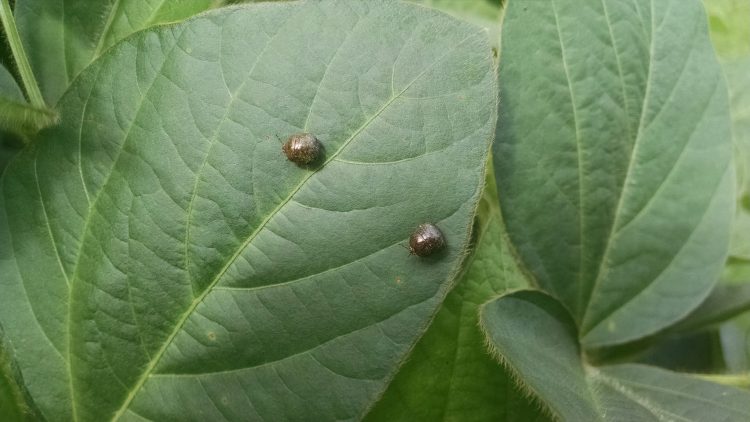Authored by Ethan Carter, Regional Crop IPM Agent and Danielle Sprague, Jefferson County Extension Agent
It’s that time of year again, kudzu bugs (Megacopta cribraria) also referred to as globular stinkbugs, have recently been found in extremely high populations across several counties and are overtaking vegetable farms and gardens. Kudzu bugs have several generations per year and with the recent mild winters, it is no surprise that we are seeing lots of them this summer.
The main crops impacted on farms and i gardens are legumes, specifically different types of peas and beans. When in close proximity, it is possible that these insects will be smelled before they are seen because kudzu bugs excrete a foul odor as a defense mechanism when disturbed (similar to stink bugs).
Adult kudzu bugs are about 1/6 – 1/4 of an inch long, somewhat oblong in shape, and olive green with brown speckles.
–
Their piercing sucking mouthparts cause feeding damage to plant leaves, stems, flowers, and pods. Excessive feeding injury can result in necrotic areas, stunting, and abnormal growth. The large populations currently frustrating homeowners can be viewed from a commercial agriculture perspective as our “canary in a coal mine”. If large populations are already found in small localized garden patches across the region, scouting commercial fields is imperative because kudzu bugs are sure to show up there, if they have not already. Late season soybeans and double cropped systems can also expect to see these pests as their populations will only build over time.
Pyrethroids will offer effective control of kudzu bugs. The table below provides several commercial insecticide options for field crops adapted from the 2019-2020 Vegetable Production Handbook of Florida (page 188-189) and the 2020 Georgia Pest Management Handbook (page 241). These products are not available for use on all legumes and some may have special restrictions, refer to their labels for more information. For small farm, garden, and residential use, over the counter pyrethroid insecticides can easily be identified as those with active ingredients ending in ‘ate’ or ‘thrin’.
| Brand/Product | Active Ingredient | Label Rate (per acre) |
| Besiege | chlorantraniliprole; lambda cyhalothrin | 5-10 oz |
| Brigade 2EC | bifenthrin | 5.12 – 6.4 oz |
| Mustang Maxx | zeta cypermethrin | 3.2-4 oz |
| Warrior II | lambda cyhalothrin | 1.28-1.92 |
Note this is not an exhaustive list and all product labels need to be checked to confirm that these products are approved for your specific legume (pea, bean, soybean, etc.).
Before an insecticide application is made, it is wise to inspect the area for signs of a Beauveria bassiana, a beneficial fungus that infects kudzu bugs. Beauveria bassiana affects kudzu bug populations throughout the Southeast and causes them to crash. If this fungus is present in the field, it may warrant delaying a pesticide application (and therefore saving the cost of that application).

Adult kudzu bug infected with Beauveria bassiana. Photograph by Jennifer Bearden, UF/IFAS Extension.
–

Adult parasitic wasp (Paratelenomus saccharalis) that preys on kudzu bugs. Photograph from the Florida Department of Agriculture and Consumer Services.
Another beneficial organism that helps combat kudzu bug populations is the parasitic wasp Paratelenomus saccharalis, documented in Georgia back in 2013. However, this wasp is very small and not as obvious as kudzu bugs covered in fungus. The small wasp is an egg parasitoid, meaning it lays its eggs in the egg case of kudzu bugs, later hatching and feeding on the developing kudzu bug inside its own egg (killing it).
For questions about kudzu bugs or other insects damaganing crops, please contact your local UF/IFAS Extension Office.
–
More information pertaining to kudzu bugs or these beneficial organisms can be found in the articles linked below:
-
UF/IFAS Featured Creatures Article on Kudzu Bugs
-
Bean Plataspid (Kudzu Bug) Biological Control
-
Another Natural Enemy of Invasive Kudzu Bug Arrives in North America
- 2024 Panhandle Row Crop Short Course Highlights & Presentation Links - March 8, 2024
- 2024 Wiregrass Cover Crop Field Day – Rescheduled – March 29 - February 16, 2024
- Panhandle Row Crop Short Course – March 7 - February 9, 2024


